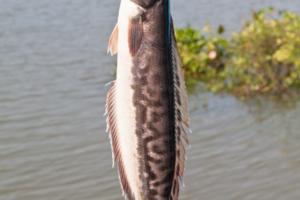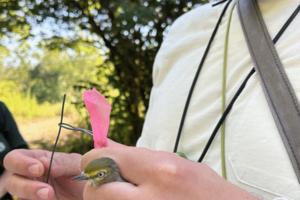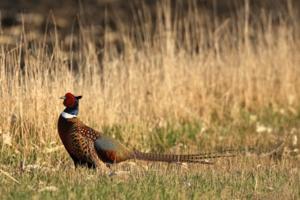Sports
/ArcaMax

'Top predator': As snakeheads invade area waters, scientists rush to understand the impact
PHILADELPHIA — Geoff Smith, a biologist with the Pennsylvania Fish and Boat Commission (PFBC), unfurled a weighted seine and plunged it into the water last Monday at John Heinz National Wildlife Refuge.
Smith and two other PFBC scientists dragged the net through the shallows of the Heinz impoundment, a sprawling wetland in Philly fed by Darby...Read more

Dennis Anderson: Carson Wentz carries football, hunting and Bible lessons to the Vikings
MINNEAPOLIS — Carson Wentz might be the only quarterback in the NFL who tosses a football with his right arm but shoots a bow with his left.
Granted, very few archers sling a football for a living.
But the right-arm, left-arm switcheroo is a head-scratcher nevertheless, and prompts a question: Is the recently acquired Vikings backup ...Read more

Pittsburgh city birds outnumber suburban and country cousins in this count
PITTSBURGH — Birds descend from the sky at dawn to take a break after their red-eye flight migrating south.
Where do they get breakfast and other meals to refuel for their journeys south, with some flying thousands of miles to reach their wintering grounds in South America?
During fall migration, Hays Woods, Pittsburgh's newest park, hosts ...Read more
Best times for anglers
(Table for Sept. 21-Oct. 5)
This table lists top fishing times and days for the coming weeks. For best results, begin fishing one hour before and continue one hour after the times given. Times apply to all time zones.
———
Sunday………........11:40 a.m.....…………………..........................................Midnight
Sunday...Read more

'A little early,' changing leaves flip switch to fall in Minnesota
MINNEAPOLIS — Autumn doesn’t officially start until Sept. 22, but it already looks like the beginning of fall in parts of northern Minnesota.
The U.S. Forest Service’s regional fall color report last week singled out the Chippewa National Forest, where it said the transition already is striking: “Trees show hints of yellow, orange and ...Read more

Number of Minnesota pheasants jumps 50% from 2024, according to August roadside survey
MINNEAPOLIS — The number of Minnesota pheasants counted in a recently completed August roadside survey jumped nearly 50% from the tally recorded last year, coming in 21% above the 10-year average, according to the Department of Natural Resources.
Steven Woodley, acting DNR upland game research scientist, said all regions of the pheasant range...Read more

Dennis Anderson: After nearly 60 years on outdoors beat, Ron Schara remains 'Minnesota Bound'
MINNEAPOLIS — Ron Schara was hired by the Minneapolis Tribune in 1967 to pen that newspaper’s outdoors column. He was making $6,000 a year writing for the South Dakota Game, Fish and Parks Department, and the Tribune offered him twice that amount.
“I took it,” Schara said. “Part of my interview was over lunch with the sports editor, ...Read more
Best times for anglers
(Table for Sept. 14-Sept. 28)
This table lists top fishing times and days for the coming weeks. For best results, begin fishing one hour before and continue one hour after the times given. Times apply to all time zones.
———
Sunday……….........5:35 a.m.......…...…….……...........................................6:10 p.m.
...Read more

Angler's odd catch requires explosives team to show up at boat ramp, Tennessee cops say
Giving new meaning to the fishing term “catch and release,” a Tennessee angler reeled in something bat shaped that proved to be an undetonated explosive from World War II, officials say.
It happened Wednesday, Aug. 27, and resulted in an explosive ordnance disposal (EOD) team being dispatched to the Sequoyah Hills boat ramp in Knoxville, ...Read more

Dennis Anderson: It's time for a Minnesota duck summit, and the DNR should lead it
MINNEAPOLIS — “We stand guard over works of art, but species representing the work of aeons are stolen from under our noses.” — Aldo Leopold
That early teal and over-water goose hunting seasons will be offered beginning Sept. 6 by the Minnesota Department of Natural Resources, followed by a Youth Waterfowl Weekend, is evidence of just ...Read more

Beth Rankin: Denver's best fly-fishing shop recognizes that women do, indeed, fish, too
DENVER — When I first started fly-fishing in Colorado four summers ago, I quickly learned that not all outfitters and guide services are set up for every angler — or any female anglers at all.
Sometimes, that meant tripping over borrowed men’s waders that were three sizes too large, or face-planting in the Eagle River because the ...Read more
Best times for anglers
(Table for Sept. 7-Sept. 21)
This table lists top fishing times and days for the coming weeks. For best results, begin fishing one hour before and continue one hour after the times given. Times apply to all time zones.
———
Sunday………........Midnight.........……….................................................12:05 p.m.
...Read more

Dennis Anderson: Minnesota's deer hunt will be big this fall; Here's what to know
MINNEAPOLIS — Challenging as it is to think about deer hunting when Pronto Pups beckon from the State Fair, a license buying deadline looms for perhaps hundreds of thousands of Minnesotans who hope to fill their freezers with venison for the coming winter.
Sept. 4 is the cutoff date for whitetail hunters to apply for special hunts in parks ...Read more
Best times for anglers
(Table for Aug. 31-Sept. 14)
This table lists top fishing times and days for the coming weeks. For best results, begin fishing one hour before and continue one hour after the times given. Times apply to all time zones.
———
Sunday……….........6:05 p.m.....…………………............................................6:35 a.m.
...Read more

Game Commission opens rare new public lands for hunters and hikers in Pittsburgh
PITTSBURGH — The Pennsylvania Game Commission, along with hiking and land conservation groups, officially opened a new game land in Indiana Township on Friday.
Large, new parcels of public land for hikers and hunters are a rarity in Allegheny County.
The game land's grand opening is special because of its proximity to Pittsburgh and location...Read more

As more hunters donate deer venison to food banks, higher donations are expected from farmlands this year
PITTSBURGH — The nonprofit Hunters Sharing the Harvest anticipates more growing pains as donations of deer from hunters increase.
The wildly successful program accepts deer from hunters, then pays to process the venison into ground meat and distributes the meat to food banks, soup kitchens and other charitable organizations across the state. ...Read more
Best times for anglers
(Table for Aug. 24-Sept. 7)
This table lists top fishing times and days for the coming weeks. For best results, begin fishing one hour before and continue one hour after the times given. Times apply to all time zones.
———
Sunday………...........1:00 p.m.......…...…….……...........................................1:20 a.m.
...Read more

Where only the carp can thrive: Meet Ocheda, one of the unhealthiest lakes in Minnesota
MINNEAPOLIS — One of the unhealthiest lakes in Minnesota is 5 1/2 miles long and stretches into three pools that, when viewed from above, look like a wasp about to sting. It’s a few miles north of the Iowa border in the city of Worthington, where its waters, cloudy with muck and festering algae, choke out the sun.
In Lake Ocheda few plants ...Read more

This lake can lay claim to the title of fishiest in Minnesota
MINNEAPOLIS — In the far north of Crow Wing County, about 30 miles beyond Brainerd, there’s a heart-shaped lake that locals don’t want anyone else to know about.
A stony brook runs through it, pouring in from the northwest shore and exiting over gentle rapids on the southeast, where the water is so clear that one could count the pebbles ...Read more

Dennis Anderson: Twins fans shouldn't complain -- losses for Minnesota bird hunters have been much worse
MINNEAPOLIS — Count bird hunters among those baffled by the angst Minnesota Twins enthusiasts have demonstrated over the club’s trades and announcement the team won’t be sold.
If anyone should complain about wins and losses in Minnesota since Calvin Griffith moved his scrappy outfit here in 1961, it should be those who will go afield in ...Read more
Popular Stories
- Pittsburgh city birds outnumber suburban and country cousins in this count
- Facing terminal diagnosis, Colorado fisherman Chad LaChance leaves legacy of outdoor education
- Best times for anglers
- 'Top predator': As snakeheads invade area waters, scientists rush to understand the impact
- Dennis Anderson: Carson Wentz carries football, hunting and Bible lessons to the Vikings





